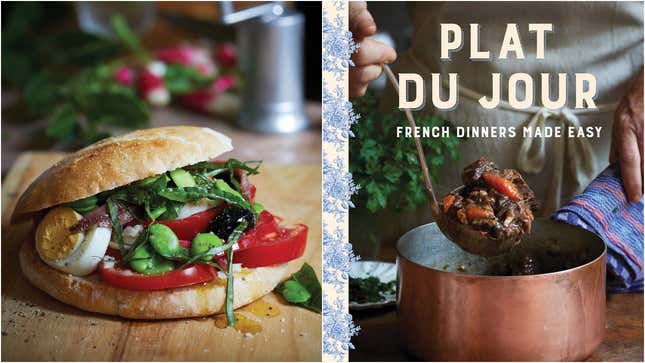
The sun is shining, the flowers are blooming, and it’s about time to get the hell out of the house and eat some sandwiches. Picnic season has finally arrived after a dreary, cold winter spent indoors, and though dining out in restaurants remains iffy, no one can stop you from loading up a basket full of tasty delights and heading outside. To make up for lost time, this year’s picnics need to be doubly delightful, so skip the ham and cheese and treat yourself to this tres Francais bathed bread sandwich instead.
This recipe comes to us from Parisian cooking teacher Susan Herrmann Loomis’ latest cookbook, Plat du Jour, and will help create the illusion you’re on vacation in Paris instead of sitting on an old blanket at a local park. We may not have the ability to travel just yet, but hey, at least we’ve got sandwiches.
“Bathed” Bread (Vegetable Sandwich from Nice)
Excerpted from Plat du Jour: French Dinners Made Easy
Anyone who has ever been to Nice has most likely had the iconic pan bagnat, this gorgeous, sunny sandwich whose beginnings are very humble. Pan bagnat means, in Provençal dialect, “bathed bread,” referring to the traditional Niçois cooks’ habit of sprinkling stale bread with water to refresh it, then adding it to a bowlful of tomatoes seasoned with salt. The salt encourages the tomatoes to give off their juice, while the bread happily soaks it all up. As time passed, the pan bagnat became more elaborate, as an increasing variety of vegetables were added; it became less humble and more structured, too, until it turned into the lovely plat du jour it is today. How does a sandwich rank as a plat du jour? Simple. You make and place this in the center of the plate, pour a glass of rosé, pull out your chair, and sit down to one of the best and most full meals of your life!
- 6 large best-quality hamburger buns
- About ¾ cup (185 ml) olive oil
- 2 tablespoons best-quality red wine vinegar
- 3 garlic cloves, sliced very thin
- 6 medium tomatoes (about 4 ounces; 120 g each), sliced into ½-inch (1.3 cm) slices
- 2 red bell peppers, seeded, pith removed, sliced very thin (for 12 slices)
- 12 radishes, trimmed, rinsed, and thinly sliced lengthwise
- Fine sea salt and freshly ground black pepper
- 6 small new onions (about .5 ounce; 15 g), trimmed and diced
- ⅔ cup (about 72) fava beans (frozen and thawed, or fresh in season)
- 6 small artichoke hearts (about 3.5 ounces; 105 g), fresh or canned
- 12 anchovy fillets, or one 12-ounce (360 g) can oil-packed tuna
- 6 large eggs, hard-cooked
- 12 black olives, pitted
- 12 large fresh basil leaves
- Fresh basil sprigs for garnish
Cut the buns in half horizontally. Pull out most of the crumb from the center of each half, leaving the crumb around the edges. This way, you make room for the ingredients.
Drizzle each cut side of the buns with about 2 teaspoons of the olive oil, and then with about 1 teaspoon of the vinegar.
Strew an equal number of garlic slices on the lower half of the buns, then top with tomato slices and an equal number of bell pepper and radish slices. Season with salt and pepper, and top with an equal amount of diced onion and fava beans, sprinkling them evenly with salt and black pepper.
Very thinly slice the artichoke hearts and lay an equal number of slices on top of the ingredients already in the sandwich. Crisscross each sandwich with two anchovy fillets or sprinkle each with an equal amount of tuna, and an equal number of egg rounds and olives. Lay two basil leaves on top. You’ve now got a colorful, architecturally perfect sandwich nearly ready to eat.
Drizzle each sandwich with an equal amount of the additional oil, place the top half of each bun on top, and press down firmly to press the ingredients into the bun. Delicately put the sandwich on a plate and garnish each plate with a sprig of basil. Serve immediately.
Astuces (Tricks):
I suggest making homemade bread for the pan bagnat. This way, you get the oversize, bun-shaped bread.
If you’re going to use canned tuna, make sure it is albacore, packed in oil. Albacore tuna don’t swim with dolphins the way other species of tuna do, so there is no bycatch; tuna packed in oil retains its wonderful texture, while that packed in water can be very dry.
Copyright 2021 © Susan Herrmann Loomis. Reproduced by permission of The Countryman Press, a Division of W.W. Norton & Company.